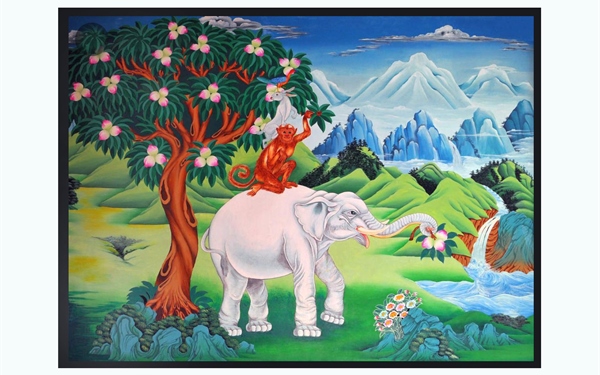- Jan 23, 2020
- 24077
Enduring Values From The Tale Of The Four Harmonious Friends
A parable steeped in Buddhism, the didactic tale of the four harmonious friends is regarded as the national folklore of Bhutan.
By Zann Huizhen Huang | Daily Bhutan
One of the most commonly recurring theme in Bhutanese folk art, the ‘Four harmonious friends’ namely - the elephant, the monkey, the rabbit and the bird can be found on the murals of many monastery walls and stupas.
Regarded as the national folklore of Bhutan, the four harmonious friends are popular household decorative items such as paintings and are also sold as wooden sculptures for display.
Brief origins of the ‘Four harmonious friends’
A parable steeped in Buddhism, the didactic tale of the four harmonious friends is also well-known throughout Tibet, Mongolia and India.
The primary source of this story likely originated from the canon of Tibetan Buddhism, the Vinayavastu, found in the first section of the Kangyur.
Other ancient sources include: the Pali canon of Theravada Buddhism as well as the texts of the Mahasamghika, Mula-Sarvastivada and the Sarvastivada orders.
A didactic tale
The iconic image of an elephant carrying a monkey, a rabbit and a bird on top of one another as they stood together under a fruit tree sets one’s mind thinking about what it symbolises.

Photo:Bhutan Natural
The delightful tale begins like this: an elephant, a monkey, a rabbit and a bird lived by a huge fruit tree.
Out of curiosity, the four animals sought to find out who is the oldest amongst them, by measuring their age with the tree.
According to the elephant, the tree was already fully grown when he was young while the monkey said that it was still small back then.
As for the rabbit, the tree was a mere sapling when it was a little bunny and when it came to the bird’s turn, it said:
“I ate the fruits of a great tree nearby, then excreted the seeds from which this tree grew.”
Henceforth, the little bird was recognised for its seniority, followed by the rabbit, the monkey and lastly the elephant.
Source: Youtube/Tshering Yangzom
From then on, the four friends lived in harmony, with due respect given to the eldest, as they tended to the tree and helped one another to enjoy its sweet fruits.
Morals of the story
While it may seem that the elephant deserves to be accorded the highest respect based on its size and strength, it is actually the little bird that holds this position, based on its seniority.
Therefore, the moral value that this tale is trying to impart is that communal harmony can be achieved through respect for one another based on age, as a barometer of one’s experiences in life.
However, it has also been argued that respect based on seniority is not always the best gauge of a person’s character or wisdom.
Especially in the realm of monastic life, respect is measured according to the number of years that one has been ordained as a monk, rather than the actual age.
Moreover, respect has to be earned from both sides. Spiritually, this is gauged based on one’s progress in the practice of the Dharma and the accumulation of merits.
Mural of the Four Harmonious Friends painted on a monastery wall
Photo: Beatrice Travels
Nonetheless, there are some who still believe that respect should be accorded using age as a guideline as Tachibana pointed out, ‘the maturity of age is generally the sign of much experience’.
The fact that the four animals of different sizes and age could co-operate and live together harmoniously and enjoy the ‘fruits’ of their labour suggests that the young and old can both learn from each other.
It does not necessarily infer that there should be blind submission to someone simply based on seniority.
Another valuable lesson to be learnt is that each of us, regardless of our size, age or appearance, has talents.
By synergising these talents, we could all reach further heights, following the example of the four harmonious friends who helped one another to gather the fruits for sharing.
The four harmonious friends - a seemingly simple tale and richness of its values – unity, selflessness, generosity, respect, care for the environment and nature as well as friendship, has indeed transcended through time and is well-loved by many, especially the Bhutanese.
